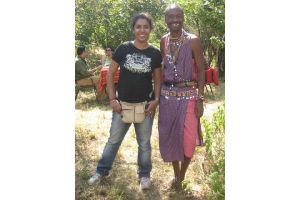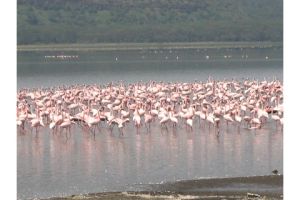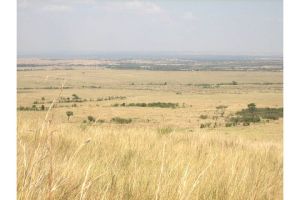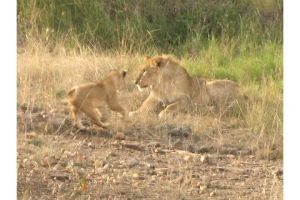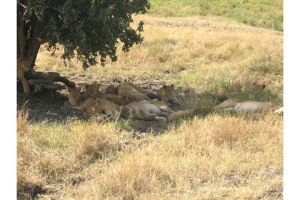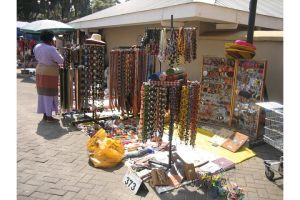By Farah Bode
WILDEBEEST MIGRATION
No wild life documentary or anything you have seen on National geographic can truly capture a firsthand migration experience which I was fortunate to see and ‘hear’. The wildebeest are called gnus and they make a sound just like their name. I can imitate something very close to it.
It was the last day in the Masai Mara. We had seen a vast herd just before our lunch and were hoping to see them do the river crossing. Post lunch to our good luck the herd had reached the river. We were on one side and they were waiting on the other..restless must say. Some of them had made it half way to the river but no one was taking the lead to cross it. We could see hundreds of them walking in single file, coming in from nowhere on the horizon, all heading for the river.
We inched closer. The disturbance caused by our vehicle sent them back and to our dismay, the ones that had come half way to the river suddenly started going back. Our guide, Ben, then relocated us further away. There were some zebra at the start of the herd. Ben told us that the zebras are a bad sign and the crossing won’t happen.
The Zebras are smart you see and will not just go headlong into a crocodile infested river.The herd started following the zebras and moved down the river bank. We were quite disappointed but then our guide told us to watch for more signs. The herd that was coming in from the horizon was ready to cross. They were all grunting the ‘gnu-hmmm’ anthem and there was a lot of shuffling as the herd was restless ..
Suddenly they started crossing and it awesome an sight to see them plunging, swimming or lunging across the river and safely reaching the other bank. Suddenly we saw a thrashing movement..a zebra was caught by a crocodile. All I could actually see with my binoculars was a huge crocodile with its mouth agape and the zebra thrashing and being sucked down into the water. An NGC moment! About a 1000 animals crossed while we witnessed what may have been the only zebra death that day at the crossing.
We couldn’t stop talking about the experience and all the locals we met thought that we were truly lucky to see the spectacle of an actual crossing, which despite the frequent ‘Animal Planet’ sightings on TV are quite rare in reality. Many of the locals have come and waited for hours at the river bank and witnessed no crossing.
Giraffe at 6 oclock
Beg, borrow, steal but you must have your own set of binoculars. I was lucky to have borrowed my own set and could point out giraffe at 6 o’clock and elephant at 9 ‘o’. Hence I was designated the official giraffe spotter for my vehicle. We were really lucky and saw giraffes, countless zebras, cheetahs (twice), the elusive leopard once and a pride of lions – twice. The beginner’s luck, they would have me believe!
Traffic jam in the jungle
The drivers are all contactable on the radio and can hear each other so if one car has seen a leopard then all the other vehicles will come to the same place and if you see my pictures you will get an idea on the traffic jam that happened over our leopard spotting. The feline then lumbered down the tree and the whole convoy of gawking tourists started following him and slowly but surely he just melted into the tall grass and was nowhere to be seen. Then he emerged on the other side and crossed right by the other groups vehicle and they got a real close up view of him.
Mofassa and me
We had just started our evening game drive when we were alerted to a sighting of lions. The male lion was sunning himself when we first spotted him. Our 4WD vehicle moved quite close to him. We named him Mofassa, after Simba’s dad from the Lion King animated movie. We observed him and his family for long. The cubs playing around. The mothers keeping a close watch. Another NGC evening!
Croc meat is very chewy!
On our last night we were all set for the famous Carnivore restaurant which has a huge spit with all possible meats on it and the exotic list featured crocodile and ostrich meat. Ostrich meat was nice and tasty, but the croc was a tough cookie I was unable to digest. Every table has a small flag, so when you are full and can’t gobble, munch, chew or gnaw anymore, you need to lay the flag down in a gesture of surrender! Just for your knowledge, Zebra meat and other exotic meat is banned since the last 3 years.
Shopping
Well, we all got ripped off and paid much more for everything except at the Masai market where we spent too little time. You will see souvenir shops during your ‘comfort’ stops. One really needs to bargain here. Start at 25% of the cost quoted. You will see at least one fancy souvenir shop at your hotel. Avoid, unless you are desperate and will not go to any mall in Nairobi which will have the same stuff at more reasonable prices. Last, but not the least, there is a Masai market on different days of the week at different malls . It’s the local Masais selling their wares laid out on mats in one area like a terrace in a mall. They sell directly to you for the best prices. We caught it on a Tuesday at the Westland mall. For my rhino mug I paid 1300 at a mall shop. It was 2200 in the hotel shop, but I paid only 570 at the masai market for another one. So much for the learning curve.
Travel tip:
The order of an itinerary should be start with Mt Kenya National park followed by Lake Nakuru and its flamingoes, then Lake Naivasha and finally Masai Mara. The Mara experience can’t be bettered!
Check out our latest package on Kenya


